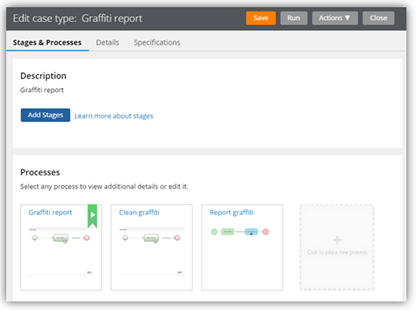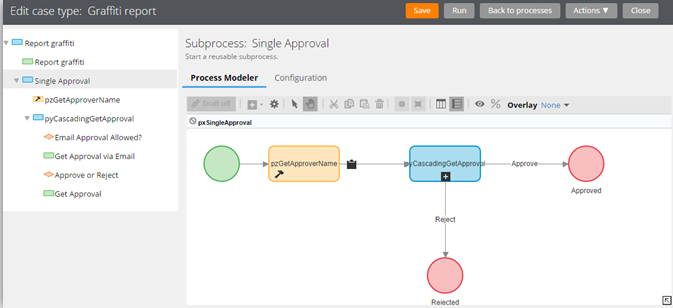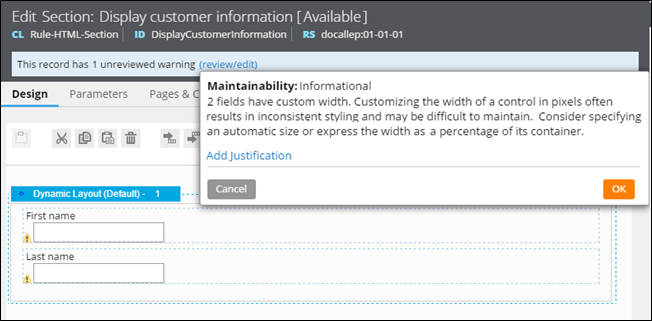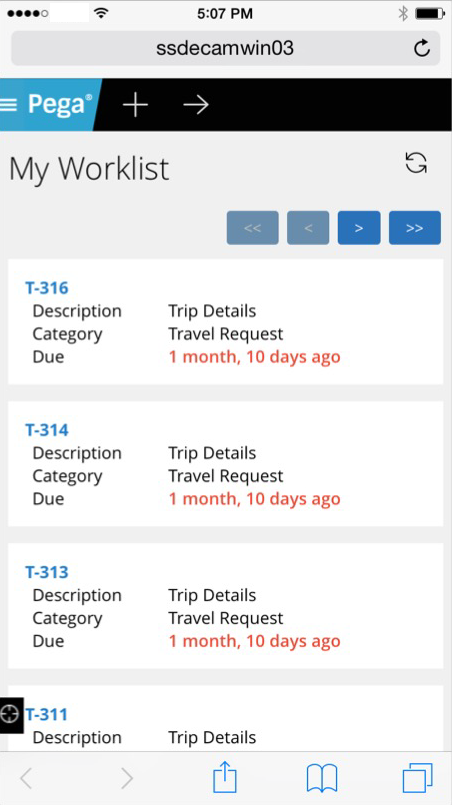View a record of Case Designer updates on the case type rule History tab
Valid from Pega Version 7.1.7
The History tab on case type rules now automatically records a history of rules edited or created from the Case Designer Stages & Processes tab. This feature allows system architects to review updates made by business analysts and other developers. It also allows business analysts to easily convey to fellow team members a record of configuration changes.
See More about Case Type rules.
Work attachment indexing fails with IBM SDK Java 6
Valid from Pega Version 7.1.7
Indexing of work attachments fails when you use IBM SDK Java 6 with Pega 7.1.7 through Pega 7.2. The workaround is to switch to IBM SDK Java 7 or Oracle JDK Java 1.6. You can also disable attachment indexing from the Search landing page; however, if you do this, you are not be able to search the content of attachments.
Edit process-based case type flows in Case Designer Process Outline view
Valid from Pega Version 7.1.7
If your case type does not employ a stage-based design, you can now employ the Step Tree and other features available in Process Outline view to facilitate your design.
Click a process tile in the Stages & Processes tab to open the flow in Process Outline. In this example, the Graffitti report is selected.

Processes in Stages & Processes tab
The process opens in Process Outline view. Note that the tree view allows you to easily see and update the underlying shapes and subprocess that compose the Single Approval process.

Process in Process Outline view
Flow action and attachment category rule types moved to Process category
Valid from Pega Version 7.1.7
The flow action and attachment category rule types now appear in the Process category within the Record and Application Explorers. Previously, they were in the User Interface and Security categories, respectively.
Support for extracting data from file attachments during email triage
Valid from Pega Version 7.4
With the Pega® Intelligent Virtual Assistant for Email, when you triage email interaction cases, the system can now use defined text analyzers to detect entities in files that are attached to the received email. The following file types are supported: DOC, DOCX, ODT, PDF, RTF, and TXT. This feature improves the machine learning and case processing capability for the Email user channel.
For more information, see Enabling the analysis of attached files during email triage.
Support for large binary data item storage in Pega Mobile Client and offline case attachments in Pega Platform
Valid from Pega Version 7.4
Pega® Mobile Client can now store and synchronize large binary data items and their corresponding actions from the action queue on Android and iOS devices. As a result, custom mobile app users can view, attach, and delete data files, whether the device is online or offline. For this function to work, you must enable offline case attachment support, which allows your custom mobile apps to synchronize case attachments between the Pega Platform and the mobile device.
For more information, see Enabling offline case attachments support and Client Store API.
Communicate guardrail compliance with the pxAddGuardrailMessage function
Valid from Pega Version 7.1.7
Now that guardrail warnings are in the model, you can easily attach them to rules in your application using the new pxAddGuardrailMessage function. Call this function to display warnings to your application users when they do not adhere to guardrails or best practices. Adopting this function in your application allows you to:
- Use localizable Rule-Message instances that are categorized by severity and application impact.
- Add dynamic warnings to your rules by passing parameters to a standard or custom message.
- Stop using and maintaining hard coded strings.

Design time view of warning messages

Run time view of an attached warning
This function supersedes the addWarning function, which has been deprecated. You can continue to use the CheckForCustomWarnings extension point, but it is recommended that you convert hard coded strings to messages and migrate any dependencies on addWarning to pxAddGuardrailMessage.
For more information on message attaching techniques, see Working with messages.
Pulse enhancements
Valid from Pega Version 7.4
The enhanced layout of the Pulse interface provides a better user experience for posting messages, adding attachments, bookmarking content, and so on. You can now post messages in your activity feed, format messages, add inline images and links to messages, reference cases, and view the list of users who like messages. The Pulse email templates have also been improved to display email content in a coherent and structured format.
For more information, see:
- Pega Express 7.4 – Communicating with Pulse
- Pega Platform 7.4 – Pulse enhancements for social collaboration
Update to UI-Kit-7:02-01-01 for latest features and mobile-ready Case Worker portal
Valid from Pega Version 7.1.7
The UI Kit ruleset (UI-Kit-7:02-01-01) contains the latest rules and a skin (pyEndUser71) for use in building or customizing Pega 7 user interfaces. Updating to this version allows you to take advantage of the newest features and styling, including a new responsive Case Worker portal.

Mobile view of the Case Worker portal
Like the Case Manager portal, the Case Worker portal is mobile-ready and provides case workers with a standard user interface for:
- Displaying a worklist of all open cases
- Viewing information about cases associated with case types defined in the Case Explorer
- Displaying a calendar view of work assignments
- Updating the user's profile
For more information, see Using the UI Kit ruleset.
Activity feed displays application messages
Valid from Pega Version 7.4
The activity feed for Pulse now displays messages within the context of the application of the logged-in user. If a user posts messages within the context of the application, all the users of the application can view the messages in their activity feed. Users can select the filter for application messages to view only these messages. For example, application messages can be used for release announcements.
For more information, see:
- Pega® Express 7.4 – Communicating with Pulse
- Pega Platform 7.4 – Pulse enhancements for social collaboration

